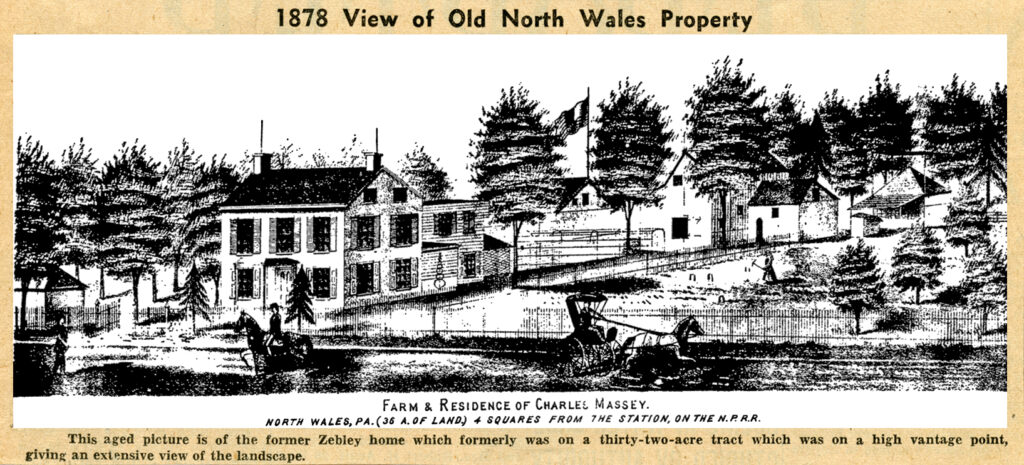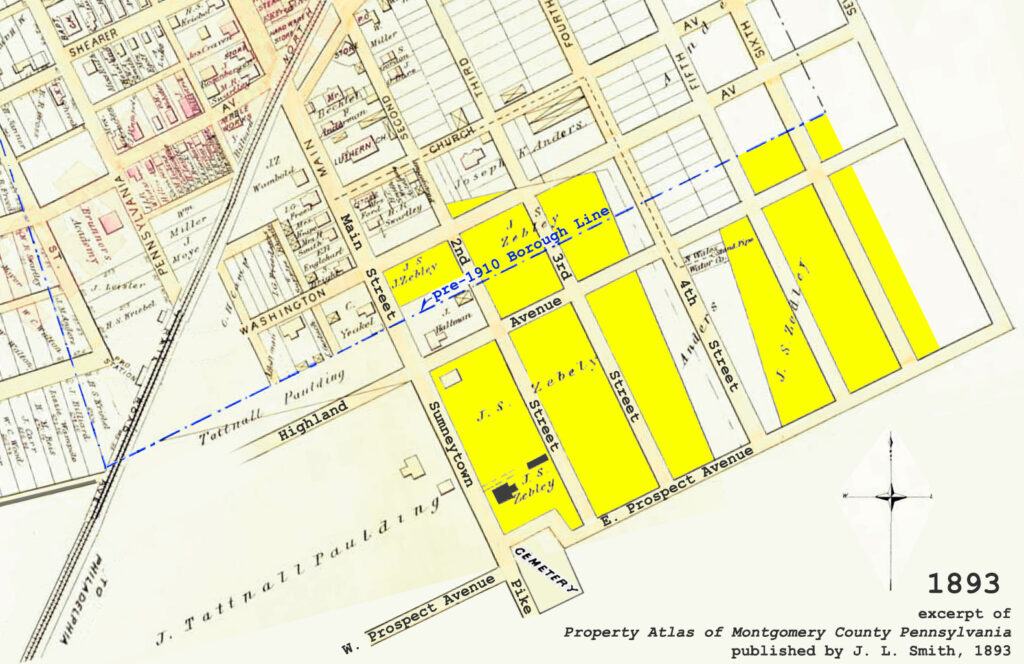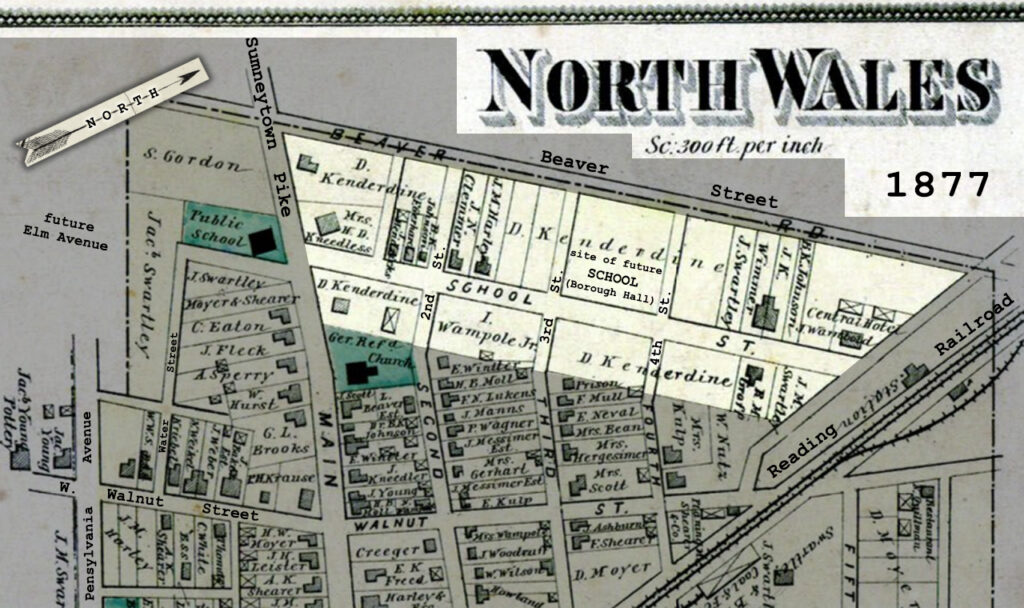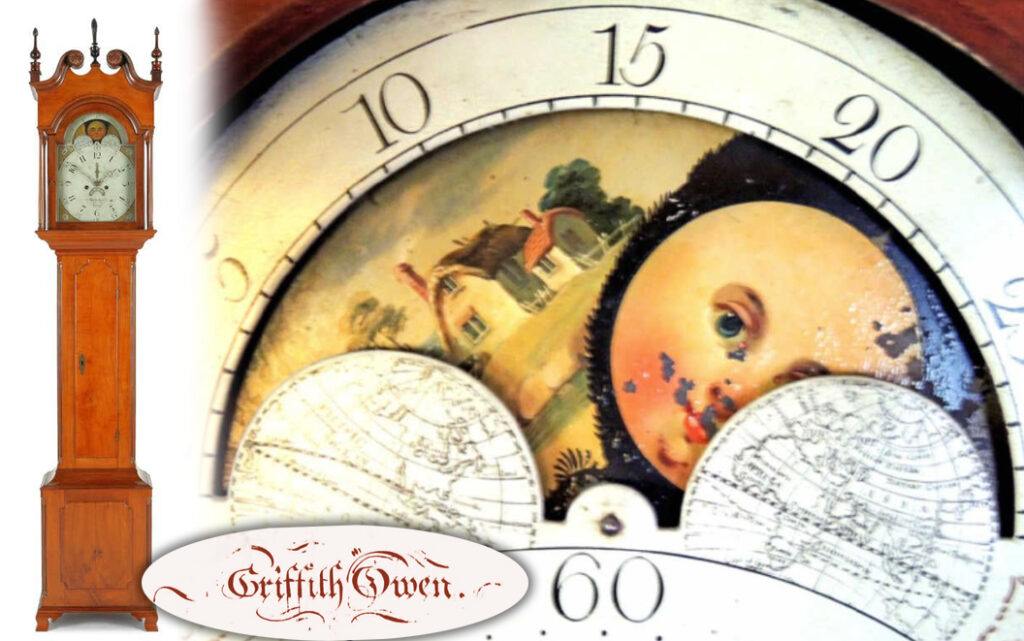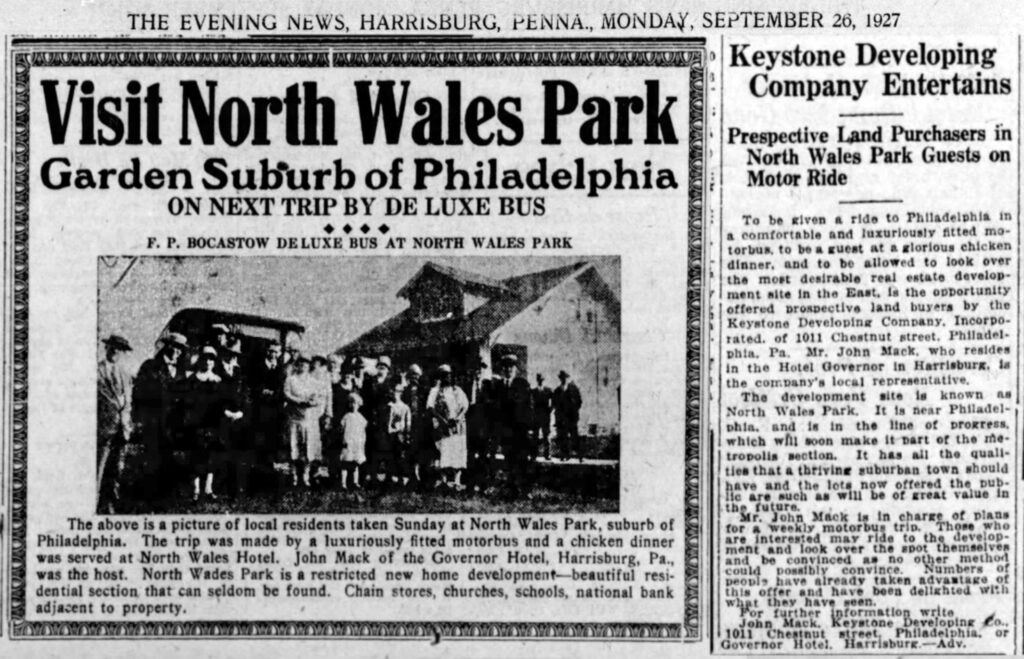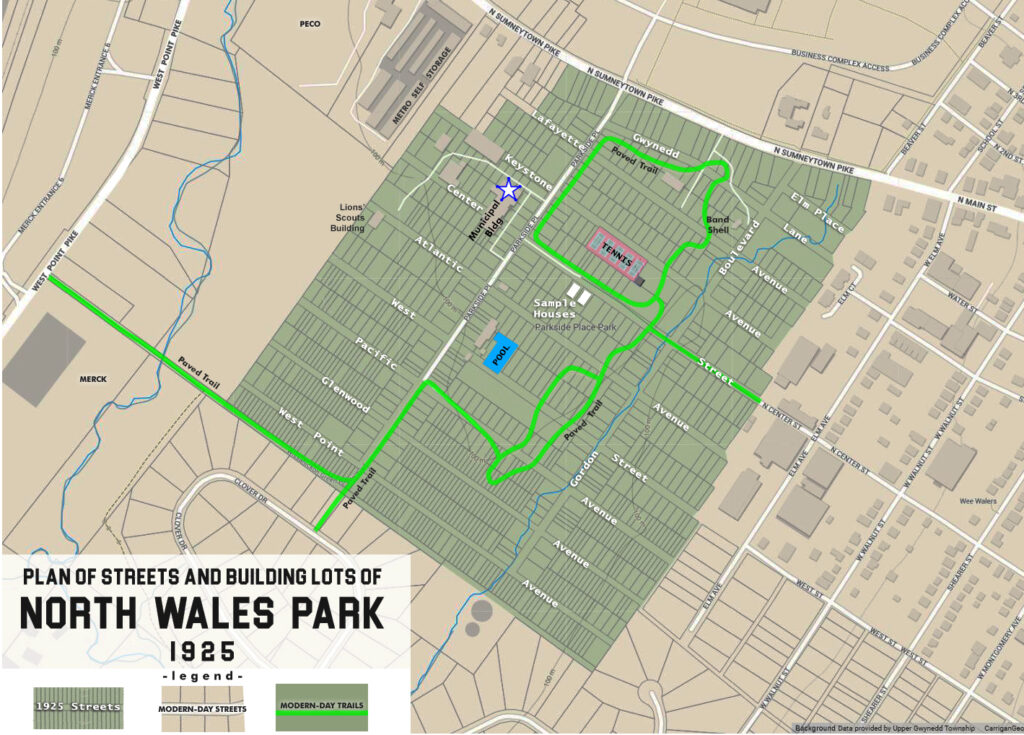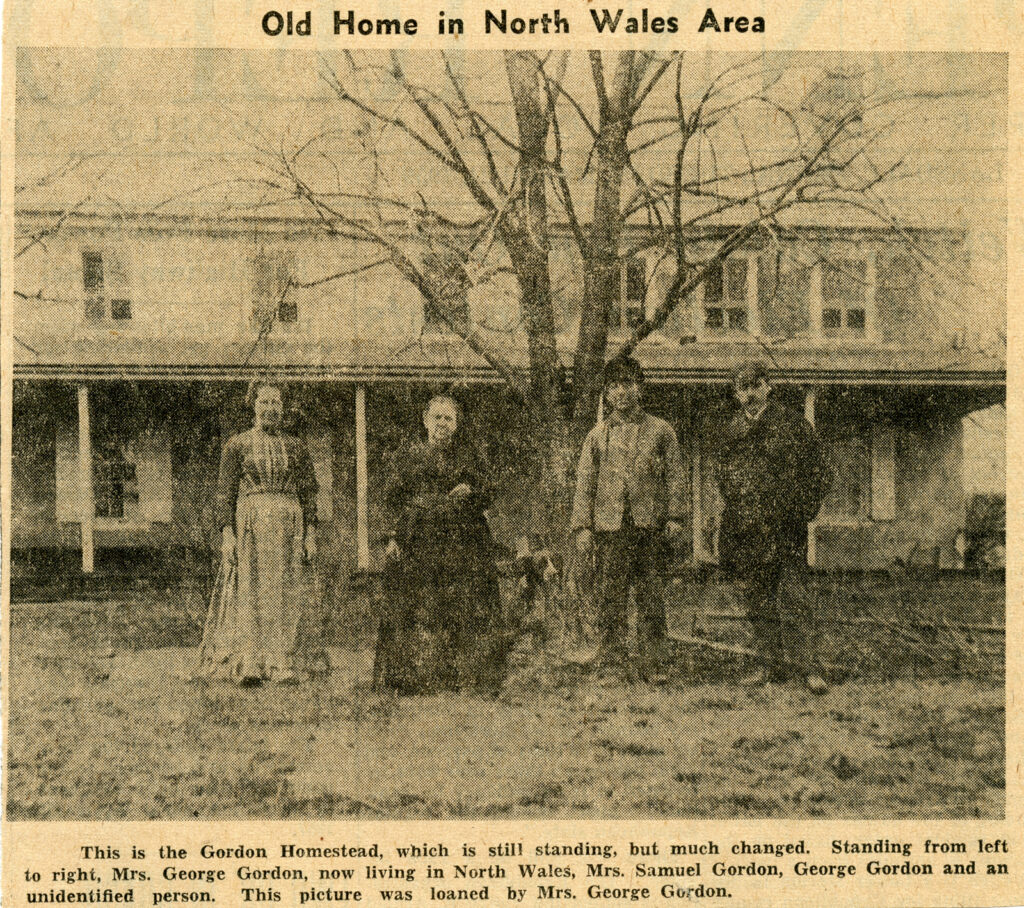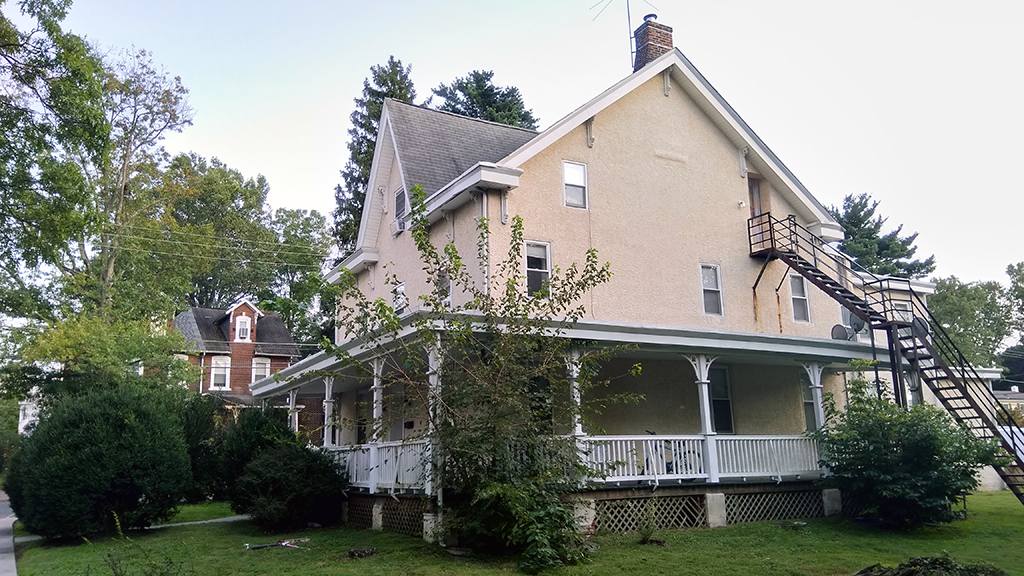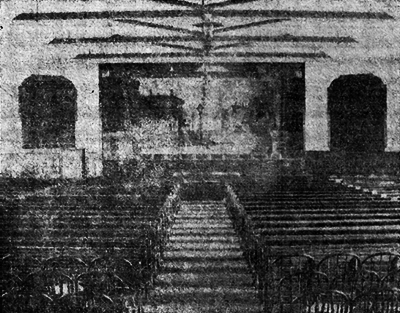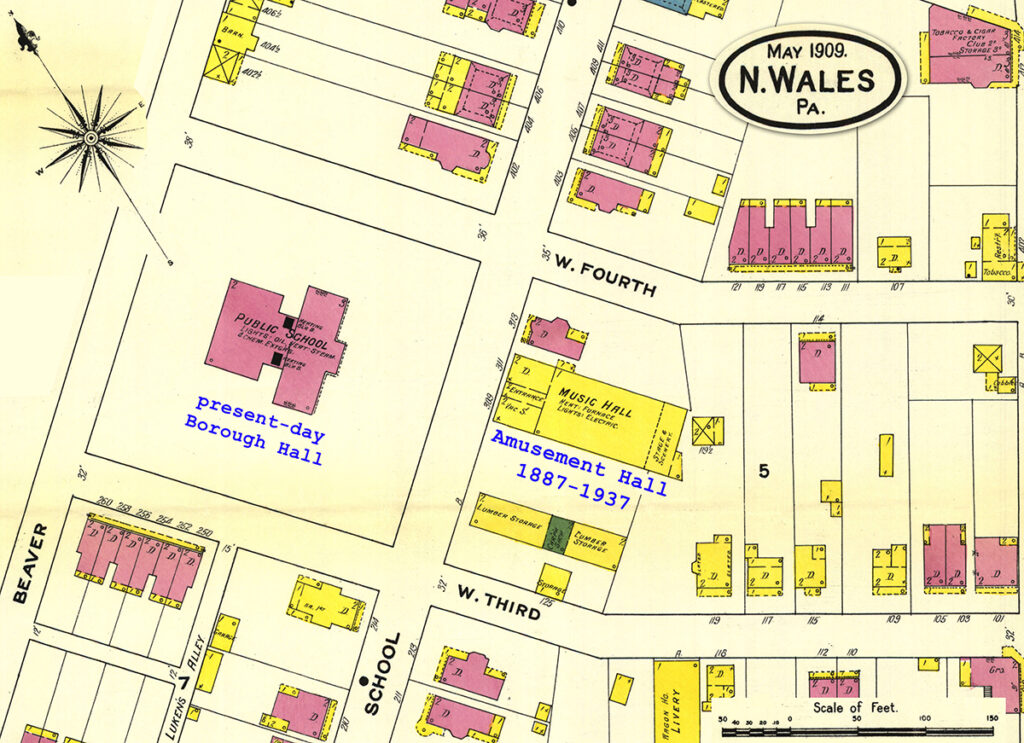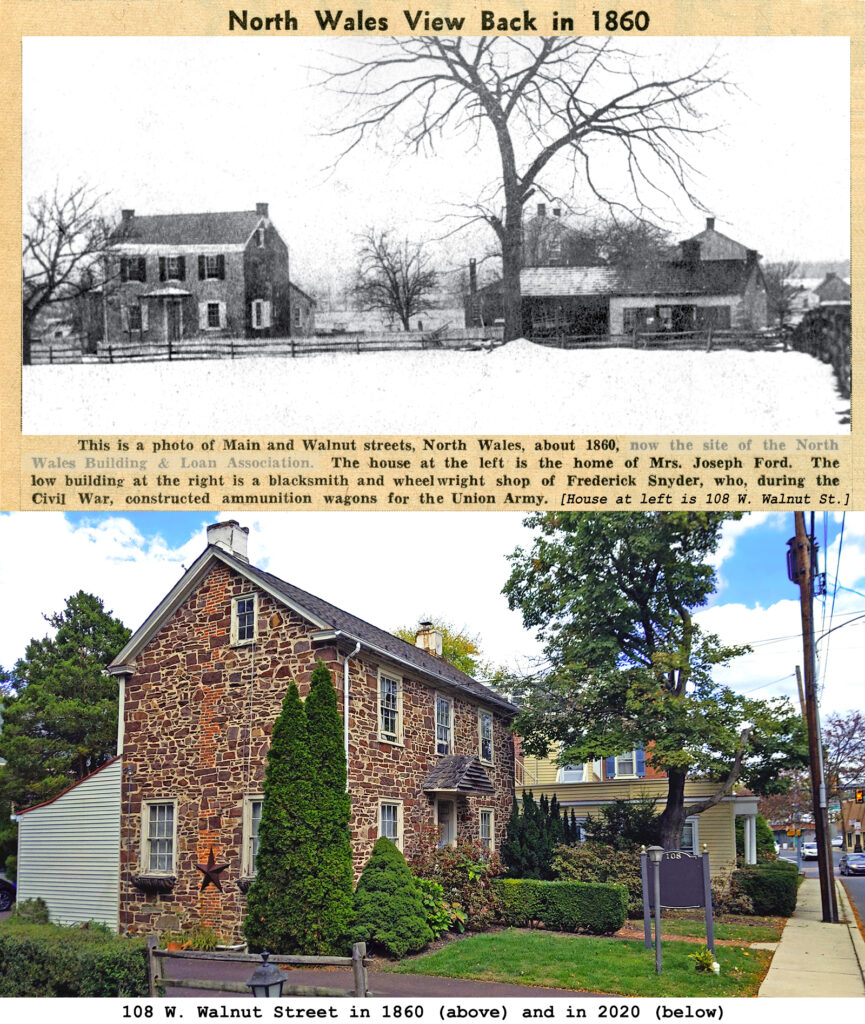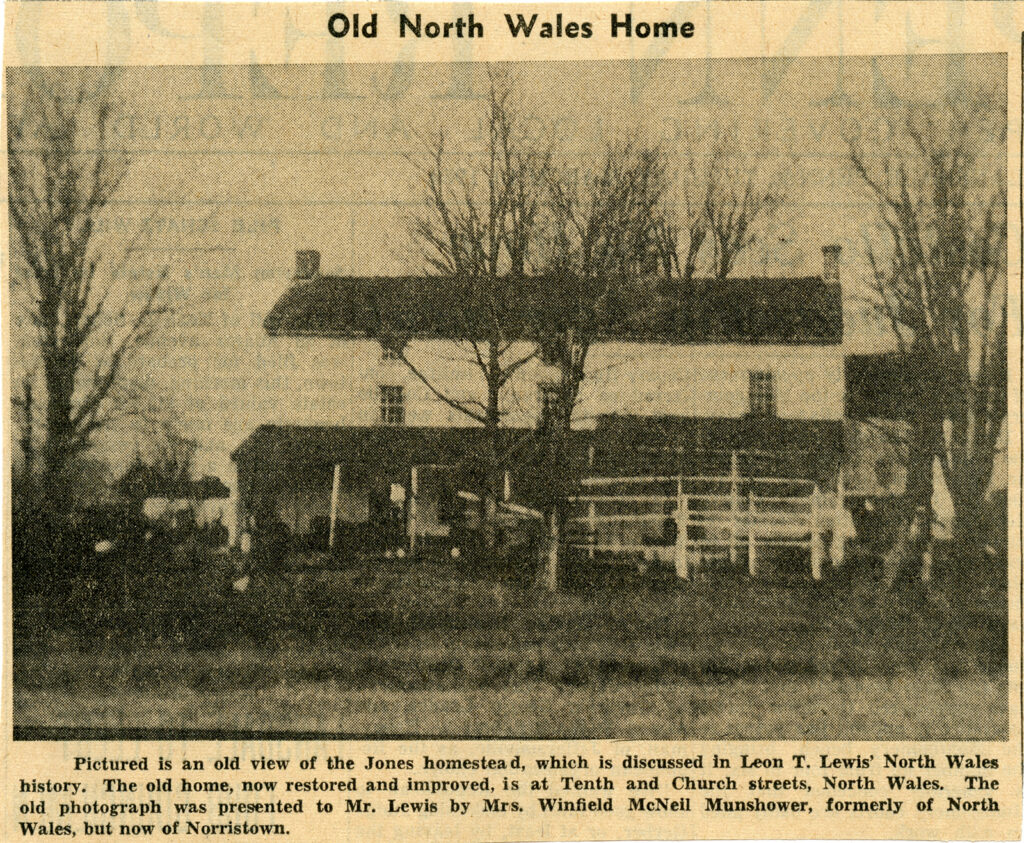The borough of North Wales is situated in central Montgomery County, about twenty miles northwest of Philadelphia. Completely surrounded by Upper Gwynedd Township, it is located on the west side of a moderate incline that slopes downward from an elevation of 450 feet above sea level at the borough’s eastern limits to 350 feet at the western limits. The central business area has an approximate elevation of 370 feet.
SETTLEMENT
The area in which North Wales is located was originally settled primarily by Welsh immigrants. Early records indicate that the first settlers established their homes in 1698. The area at that time was variously called Gwynedd, Gwineth, or North Wales Township. All of these names derived from the region of Wales from which the settlers had emigrated. In 1702 Gwynedd Township was established. The township, primarily agricultural, remained populated by the Welsh in the southern and central regions, but before 1750 several Dutch and German families had located in the northern end. North Wales appears to have been the dividing point between the two settlements. A Lenni Lenape Indian trail traveling from the northern areas of Montgomery County to the Delaware River passed directly through Gwynedd Township and the area later to become North Wales. This early trail determined the lines along which the Great Road was laid out in 1728. (This highway, now known as Sumneytown Pike, passes through North Wales as Main Street.) By 1850 improvements to the road were made by a private turnpike company that charged tolls of the horse-drawn traffic making its way to and from the markets of Philadelphia. A cluster of farms, a distillery, and a church occupied the present site of North Wales. In 1857 the North Pennsylvania Railroad, which had been delayed over a year by the construction of a tunnel in Gwynedd Township, was completed. Built to carry people, goods and anthracite coal between the Lehigh Valley and Philadelphia, the North Penn created a stop, named North Wales, where the railroad intersected with the Great Road. This intersection of two major transportation arteries attracted tradesmen and businessmen.
ESTABLISHMENT
In 1868 a petition was filed with the Montgomery County Court, requesting the incorporation of the settlement into a borough. The following quotation extracted from that petition (in the Court House) gives an idea of how quickly this hamlet developed and prospered in those first few years after the arrival of the railroad.
“. . . that Village is a thriving, growing, rapidly increasing, and active business town, containing a Depot, Lumber Yard, Coal Yard, three General Stores, Drug Store, Boot, Shoe and Trunk Store, Feed Store, Flour Mill, two Hotels, Restaurant, a Saddlery, Harness Makers, Shoemakers, Blacksmith Shops, Wheelwright Shop, Steam Moulding Sash and Door Manufactory, Brick Kiln, Churches, School House, Conveyancer, Real Estate and Insurance Offices, a Building and Loan Association, Library Association and other institutions of learning and usefulness, and about three hundred and eighty inhabitants, sixty-five of whom are freeholders.”
1868 petition filed with the Montgomery County Court, requesting the incorporation of the settlement into a borough
On August 20, 1869, the court decreed in part that “the said town of North Wales be incorporated into a borough. . . .That the corporate style and title thereof shall be ‘The Borough of North Wales.’ ” This was the first borough incorporated by the Montgomery County Court, the preceding four boroughs in the county having been created by the state legislature.
PHYSICAL GROWTH
The original borough, roughly square, encompassed about 100 acres. An almost equal amount of territory adjoining the southwest boundary was annexed into the borough in 1884, raising the total area to 195 acres. An additional 192 acres was annexed to the northeast boundary in 1910. In 1935 a small tract of about 12 acres was ceded to Upper Gwynedd Township [the northwest corner of E. Walnut Street & Beaver Street]. The most recent increase was in 1958, when a tract of about 14 acres was added along the southeast boundary.
In the first decade of its growth, or until 1880, population steadily increased, to 673. The problems facing the borough government were many. Lack of money to operate was one of the most pressing problems. The borough often borrowed funds from several citizens. Even at this early time residents demanded more and better roadways and lighting.
The North Wales Record, a weekly newspaper published from 1874 until 1942, spread the word that the town was rapidly growing. In 1890 the population was 1,060, and advertisements in the newspaper showed that many small businesses were active.
By the turn of the century North Wales had reached the high point in its growth rate. The population in 1900 was 1,287, more than triple the population only thirty-one years before.
Two large textile knitting and weaving mills, a large asbestos-processing mill, an iron foundry, and a grain-processing mill were the large employers around 1900. Still surrounded completely by farms, North Wales, with its concentration of several mercantile stores and many tradesmen, was the main shopping area for several miles around. Much of the daily traffic was created by the farmers bringing their loads of grain to the mill on Main Street, and driving herds of cattle through the streets to the cattle-loading pens for the railroad on Walnut Street.
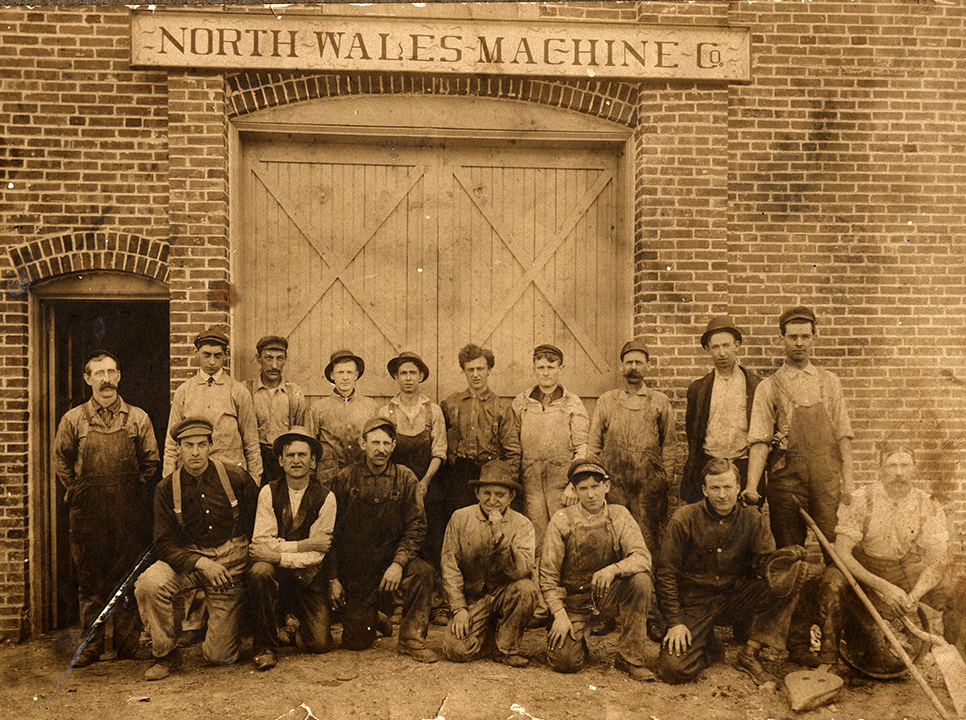
The fifteen years from 1885 to 1900 probably saw more improvements to the town than any other period. In 1885 a privately owned water distribution company was formed. This company drilled its own wells and laid pipe throughout the town and the area immediately outside it. It continued to supply water until 1951, when the borough of North Wales purchased it.
Another private company formed about 1896 to generate and supply electricity. Electric street lights were first used in 1897. A generator located in the rear of the flour mill on Main Street provided current. Later a larger generating plant was built at Third Street and Montgomery Avenue, and it remained in operation until the company was sold about 1911.
Also during this period telephone service arrived. A directory of 1901 listed sixteen local phones and two private lines. The first trolleys passed through town in 1901, and service continued until 1926, when buses replaced the trolleys.
By 1915 the town government had begun to install a sanitary-sewer system, which went into service in 1917. The collection and treatment operations worked solely by gravity and water flow power, requiring no outside source of power and little manual maintenance. This system, although modernized, remains in use today [1980].
It is not widely known that North Wales was once a summer resort area. From about 1870 through 1915 several large homes and the three hotels in town (mentioned below) catered to people who wished to escape the heat of the city and spend the summer in the more pleasant and quiet countryside.
During the second thirty-year period of its existence, the borough continued to grow but at a less rapid pace. By 1930 the population had reached 2,393. After World War I the modern technology of the rapidly advancing machine age began taking its toll on the borough’s larger industries. This, coupled with the great financial crisis in 1929, resulted in the failure of many small businesses and the reduction of employment in the larger mills.
Recovery from the Great Depression during the 1930s and the prosperity after World War II did little for industry in North Wales. However, it was during this period that industry, formerly city oriented, began to move to the suburbs, and the township area outside the borough began to grow. As industry receded, the borough began to emerge as a residential area; the population grew to 3,673 in 1960. Housing spread to the limits of the borough and spilled out into Upper Gwynedd Township. In 1950 the Borough Council took steps to control development by adopting the borough’s first Zoning Code. This code remained in effect until 1977, when a new and far-reaching code was adopted to coordinate with the county comprehensive planning program.
NORTH WALES WATER AUTHORITY
In early years a great many of the less than seven hundred residents obtained their water from a hand pump over a large well located beside the Main Street Hotel [on Main Street opposite Shearer Street]. The North Wales Water Company, formed in 1885, distributed and sold water in the borough and the immediately adjacent township area. Borough residents not served by the company relied on their own wells.
In 1951 the Borough Council created the North Wales Water Authority. The authority then purchased the water company by means of a $238,000 bond issue to be paid off entirely from the revenues of the water system.
As the postwar industrial and residential growth boom continued in the region, the North Wales Water Authority kept pace. From 1,100 customers, who required an average of 272,000 gallons per day in 1951, the authority in 1980 used about 173 miles of underground pipe to supply a daily average of over 5 million gallons to more than 10,400 customers in six townships and the borough.
COMMUNITY SERVICES
The North Wales Police Department was created by order of Borough Council in 1903, when one man was hired to serve as a full-time peace officer. Before that, police duties had been handled by constables who were called upon as needed. Norman Chestnut, police chief from 1930 to 1938, took the first step toward modernization when he obtained a motorcycle for patrol. The first patrol car was supplied to H. W. Turner, chief from 1938 to 1943. Chief Turner was also responsible for the installation of radio communication with the county radio system. Edward Veit, chief from 1943 to 1966, urged the council to hire an additional patrolman, that position first being filled by Joseph Whitley in 1944. Whitley was promoted to chief upon Veit’s death, and held the office until his death in 1973. The present force, under the direction of Kenneth Veit since 1973, consists of four men supplemented by part-time patrolmen [1980].
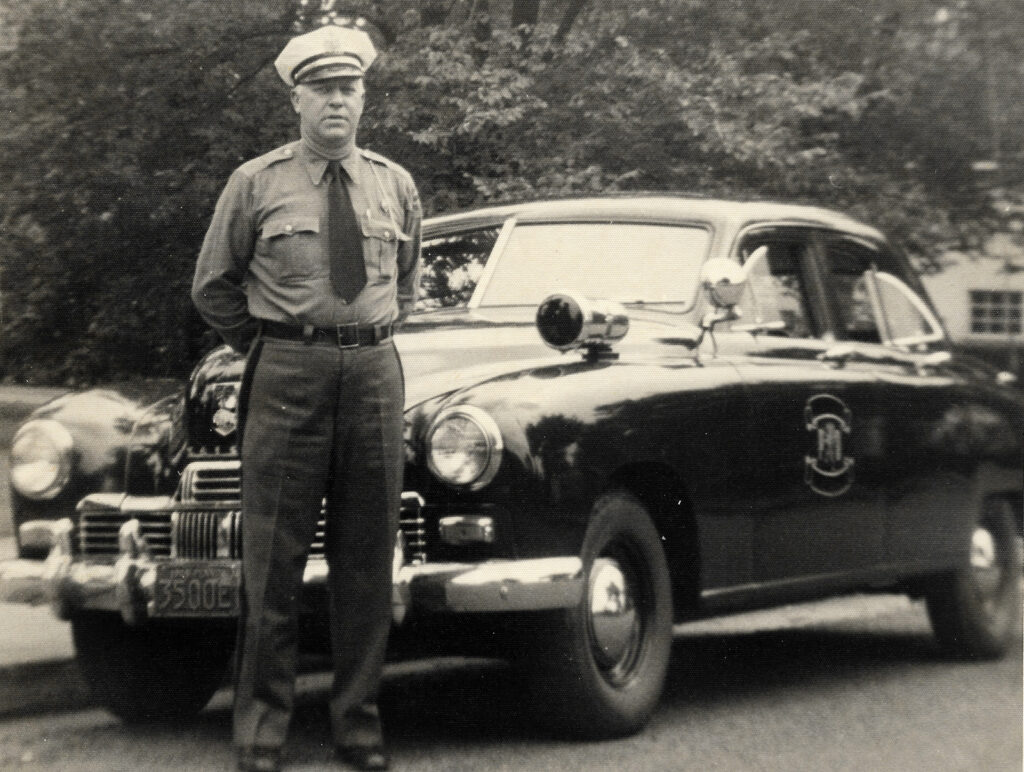
Fire protection is supplied by the North Penn Volunteer Fire Company, which was organized in 1930 in North Wales. Before then, the borough had a municipal fire company and associated equipment. The men were paid only for time spent fighting fires. The inability of the council members and the firefighters to agree on the type of equipment and operational methods caused the dissolution of the borough-controlled department and the creation of the new volunteer company. Today this well-trained and well-equipped organization is totally volunteer and operates with funds received from private donations and grants from local municipalities.
The North Wales Memorial Free Library, located [in 1980] in the elementary school building on Summit Street, is also a volunteer organization that operates on private donations and government grants. The library was founded in 1923, primarily through the efforts of the Woman’s Civic Club of North Wales, and supporting the library has been an ongoing project of the club ever since. An unsuccessful attempt had been made to form a library in 1885, when the Union Library operated in the second floor of a small office at Fifth and Walnut streets. Lack of support and interest ended this effort, and after only a few years it was abandoned.
SCHOOLS
A small building located at the southwest corner of Main Street and Elm Avenue served as the public school until a large two-story brick building was erected in 1887 on School Street between Third and Fourth streets. Some years later the school acquired a three-story addition to the front of the building. This building served as the only school for both elementary and high school until 1928, when a new high school was opened on Summit Street. The older school continued in use for elementary education until 1954, when it was sold to the borough and converted into a municipal building. The Summit Street building became the elementary school; the high school students were absorbed into the North Penn school system.
The North Wales Academy and School of Business was opened by Samuel Brunner in 1871 in a building on Main Street, and moved to larger quarters on the southeast corner of Pennsylvania and Montgomery avenues in 1872. This school, also known as Brunner’s Academy, offered business courses and college preparatory work. The date of its closing is uncertain but is believed to be the early 1900s.
Saint Rose of Lima School, built in 1954-56, opened its first classes in 1956 to serve the parishioners of the church mentioned below.
HOTELS AND PUBLIC BUILDINGS
Three major hotels were located in the borough. The Main Street Hotel (sometimes known by the names of its proprietors) is the oldest, having been rebuilt from a farmhouse and distillery in 1857. Located on Main Street at Lumber Street, it is used today as offices and apartments. In the rear of the hotel, on Second Street, is a two-story brick building that served as the public livery stable for the hotel. During the early 1900s the building was remodeled, and the second floor was used as a public meeting hall and lodge home.
The Central Hotel on School Street at the railroad station was built some time before 1868. This hotel contains apartments today, but continued to serve the traveling public until well into the twentieth century.
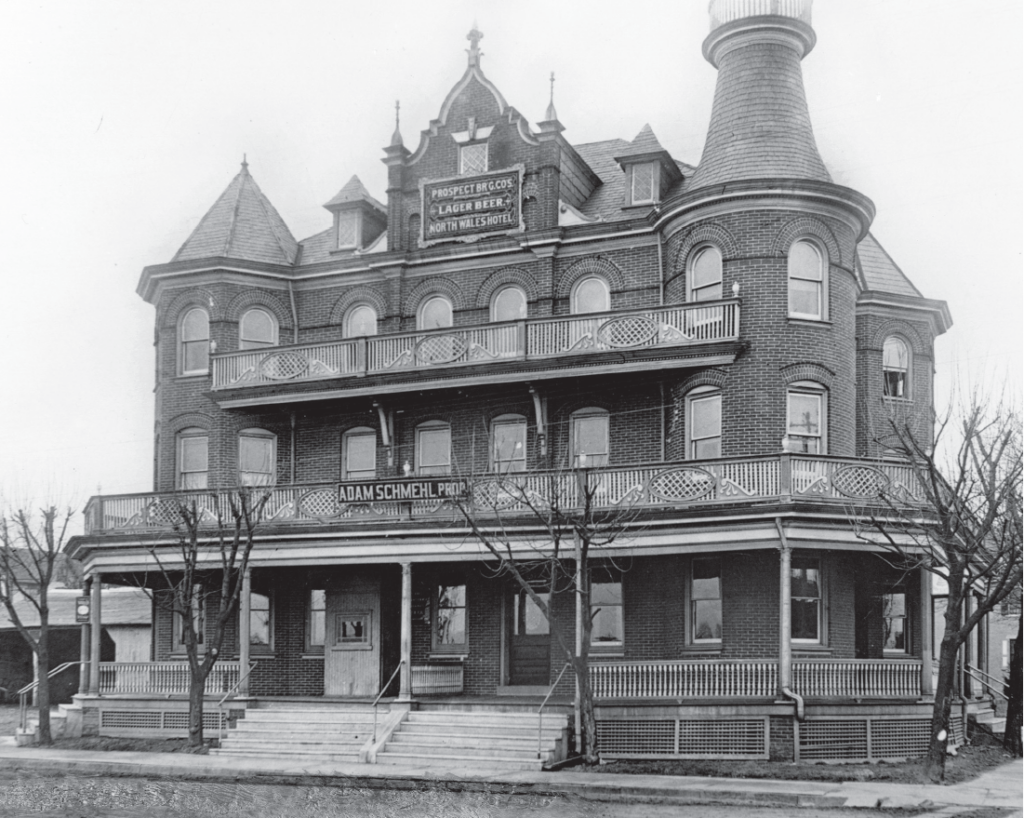
The third, the Colonial Hotel at Fifth and Walnut streets, was erected in 1893 and continued in use as hotel until 1974, when it was converted to a restaurant and tavern. It was an ornate four-story brick building and one of the fanciest in the area at its time of construction. It also had a public livery stable. In more recent years before its closure in 2014, it was home to a much-loved community gathering place, McKeever’s Tavern.
Amusement Hall was for many years the borough’s social center. The front portion of the hall was a three-story frame building on School Street between Third and Fourth streets [across from Borough Hall]. Extending from the back portion was a one-story auditorium that was reported to seat over five hundred people and included a stage. The hall was built in 1887 demolished in 1937. It was the scene of plays, graduations, basketball games, roller skating, public meetings, and cinema. The portion of the hall facing School Street was remodeled into twin houses, which still stand today.
Construction of the Municipal Building began in 1959, and the dedication was held in June 1960. The borough had obtained the land and the old School Street school building after the school authority had decided that the building was no longer suited for school use. The borough then transferred title of the property to the North Wales Water Authority, which designed and built the Municipal Building. The design removed the school’s third floor and front tower, but did incorporate some portions of the original building. In 1978 the borough purchased the property from the water authority, which had used part of it, and it is now used solely for the administration of the borough.
WEINGARTNER MEMORIAL PARK
Upon his death in 1944, John Weingartner bequeathed funds to the borough to purchase, develop, and maintain a park. Weingartner Memorial Park, created and dedicated to the memory of John and Carrie Weingartner in 1954, covers a nicely landscaped tract of about three acres on Summit Street across from the North Wales Elementary School. Weingartner Park is frequently the site of civic gatherings, musicals, and memorial services.
CHURCHES
A log cabin on the site of the present Lutheran Cemetery at Main Street and Prospect Avenue was the first home of both the Lutheran and the Reformed congregations from the middle 1770s until 1815, when it was destroyed by fire. A second church, built at the same location for the continued use of both congregations, was a stone building seating over five hundred people. The exterior, plastered with yellowish or cream-colored plaster, gave rise to the nickname the “Old Yellow Church.” In 1868 each congregation built its own house of worship in North Wales.
St. Luke’s United Church of Christ (formerly the Reformed) congregation demolished its 1868 church and replaced it with the present church in 1909.
The Lutheran Church on Main Street, although modified, is still the original structure.
The North Wales Baptist Church built its first structure on the Allentown Road on the site of the present Baptist Cemetery in 1861. This was known as the Gwynedd Baptist Church. In 1874 the congregation built the church on Shearer Street. Portions of the original building are included in the present church.
In 1870 the Methodist Church was constructed at Fourth Street and Montgomery Avenue. It acquired an upper room in 1880 and a large stone addition in 1917. In 1966 the new Sanctuary United Methodist Church was built in Upper Gwynedd Township, and the old building in North Wales was sold.
The St. Rose of Lima Catholic Church became a reality in 1915 after the parishioners had held their worship meetings for over two years in the upper floors of the planing mill on Main Street [next to today’s fire house]. The original church was never completed as originally projected; only the basement section was used for services. In 1966 the present church building on Main Street was dedicated, and the old building was used thereafter only for various meetings and functions.
POSTAL HISTORY
North Wales post office was established on May 2, 1864. Isaac Freed served as the first postmaster.
A 1980 PERSPECTIVE
North Wales Borough, predominantly residential, has a generally middle class, ethnically mixed population of 3,391. Many families living in the borough and the township trace their ancestry to the original Welsh and German settlers. The business community consists primarily of professional offices and a few small stores serving the residents of the area. Industry, which once heavily supported the borough, has mostly moved away from its limited confines to open areas where expansion does not create a problem. Only a small amount of industry remains within the borough.
Leon T. Lewis, Jr. Historian
1980
BIBLIOGRAPHY
Geisinger, John B. The Schools of North Wales. Published by the Donald McLeod Post 336, American Legion, 1941.
Lewis, Leon T. Facts about Early North Wales. Published by North Wales 85th Anniversary Committee, 1954.
Lewis, Leon T., Jr. North Wales, Its Birth—Adolescence—Maturity. Published by North Wales Centennial Cele-bration Committee, 1969.
Maag, Mrs. Andrew. A Short History of North Wales. Published by the Donald McLeod Post 336, American Legion, 1941.
North Penn Reporter. 1950-82.
North Wales Record. 1884-1941.

